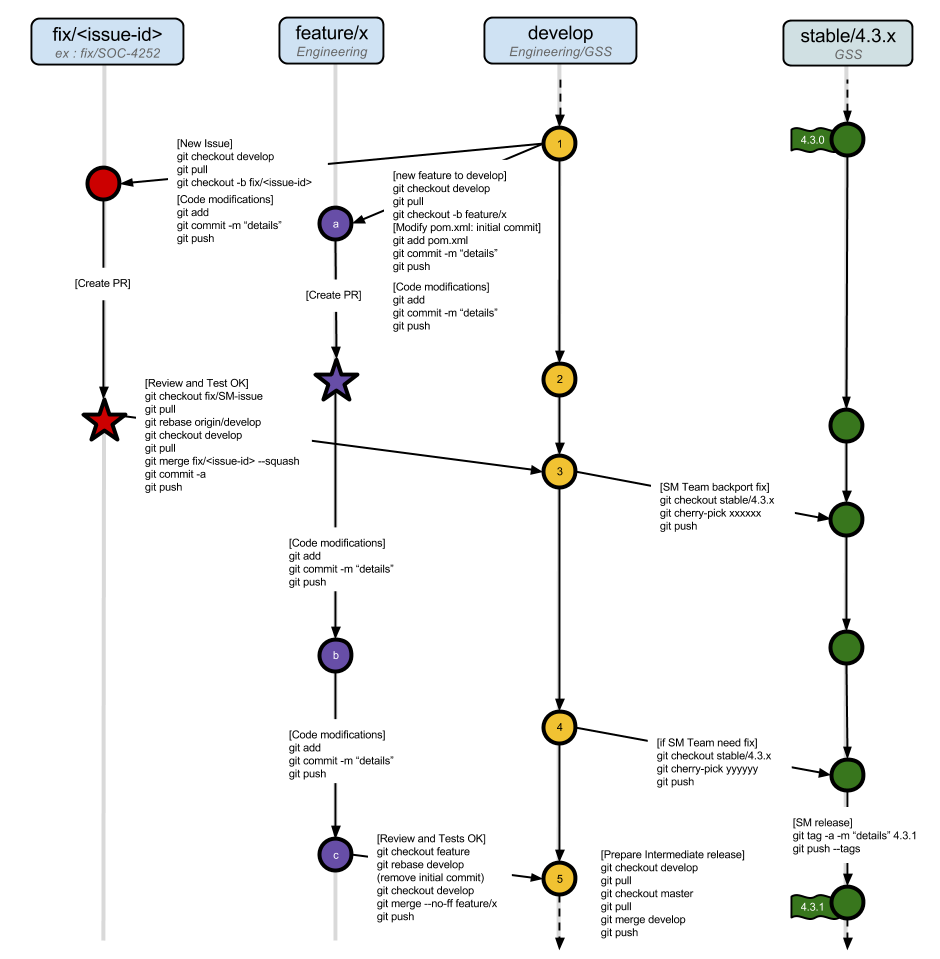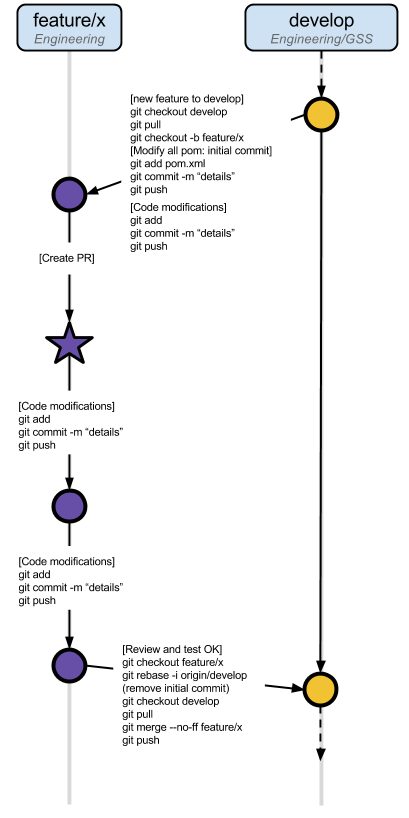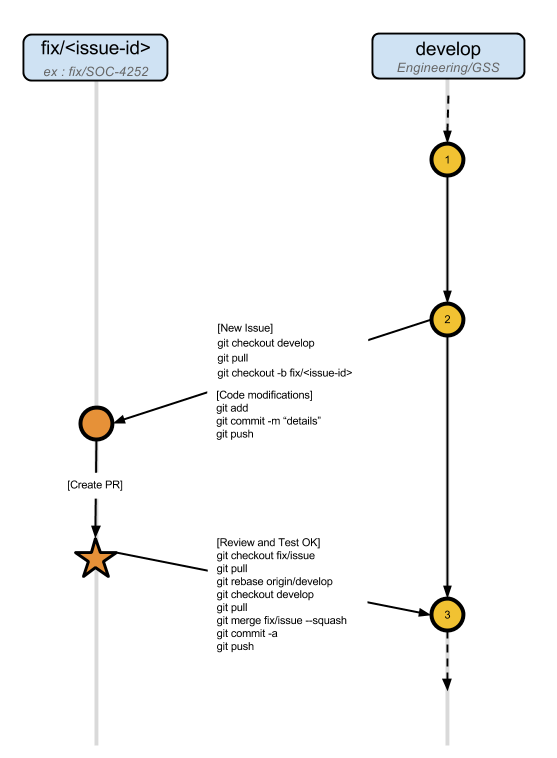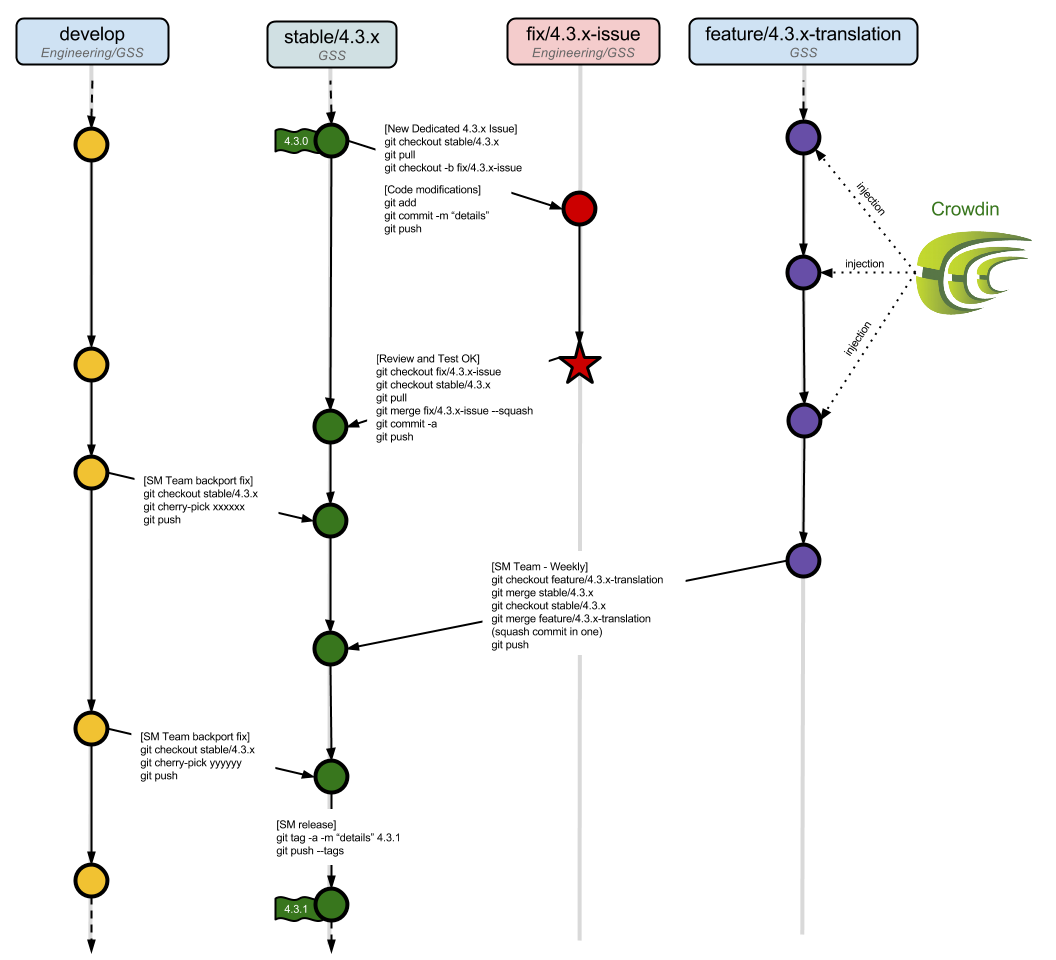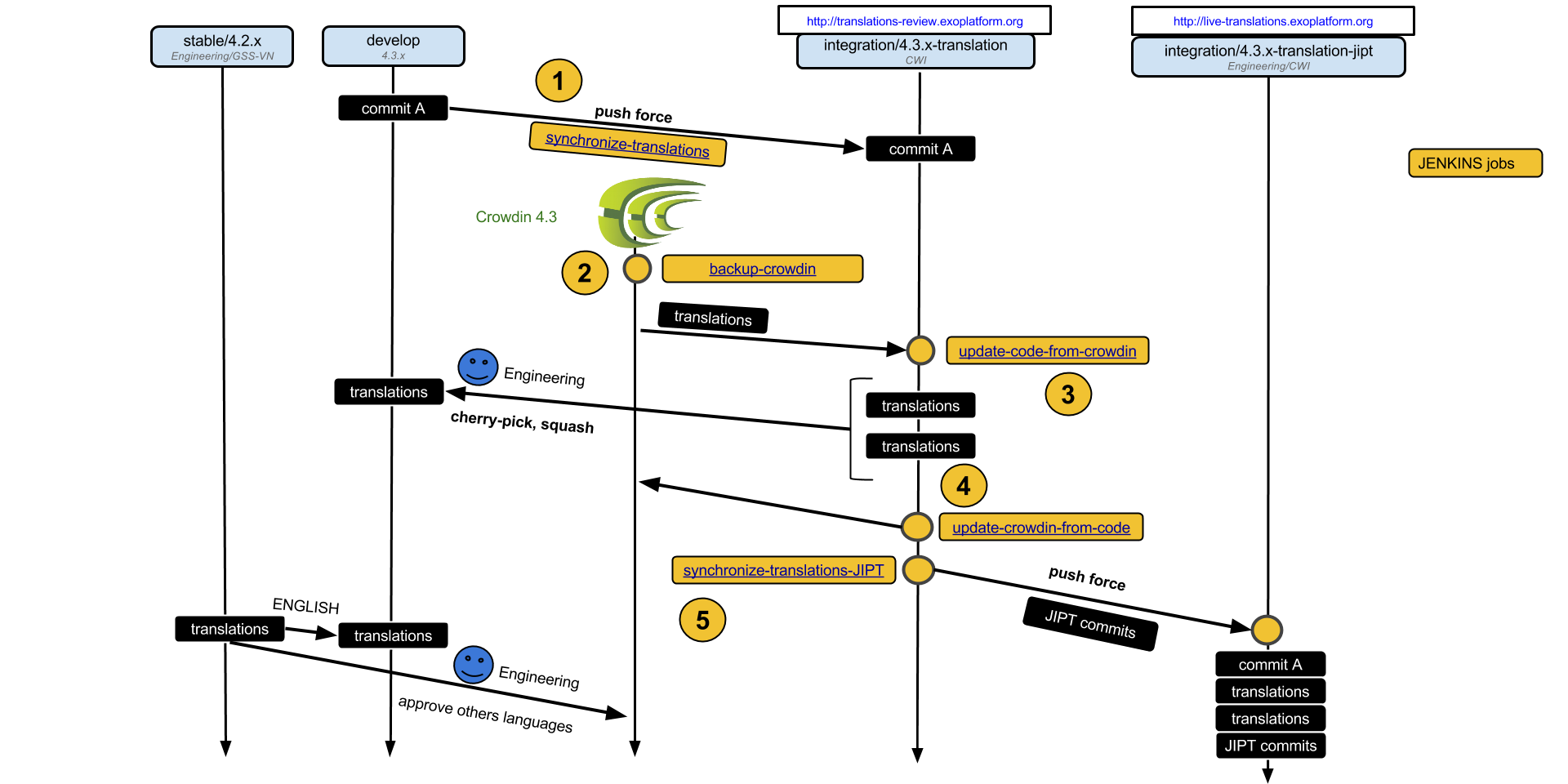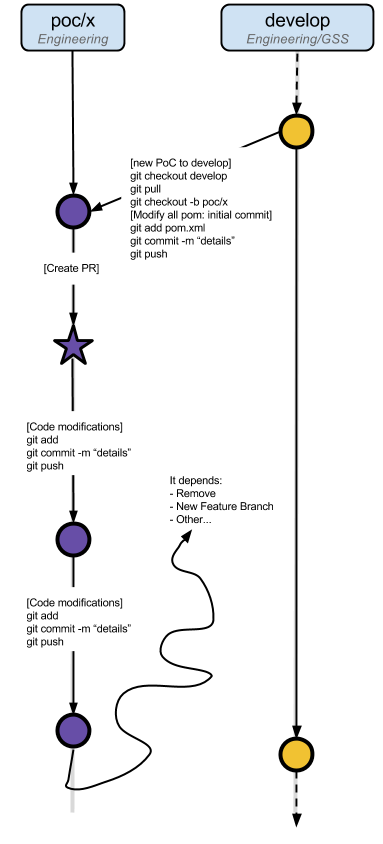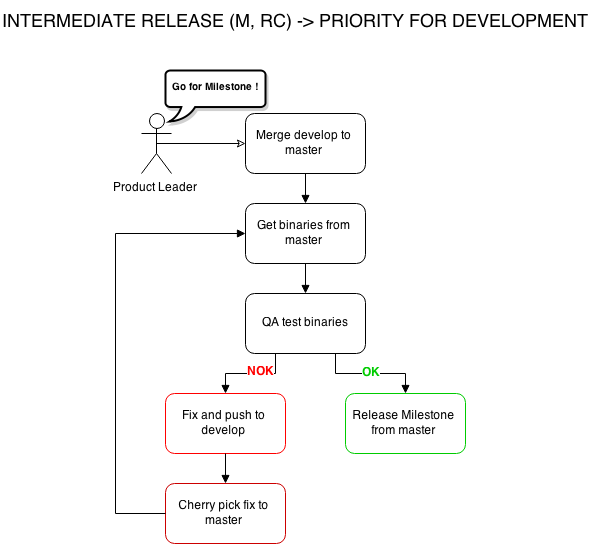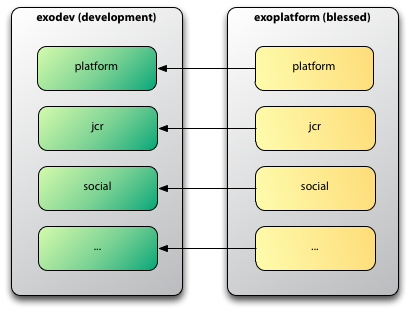
Git - Workflow
Our workflow is built on two principles :
-
The repository architecture (development vs blessed) that has to be followed by all projects involved in products produced eXo (and thus that require to be supported).
-
The branching model that has to be followed by all projects at eXo
Repository architecture
Aiming security and backup purpose, we are using two repository kinds (owned by two distinct github organizations).
These are blessed and development repositories hosted respectively on exoplatform and exodev organizations.
Development repositories are forked from blessed repositories.
This strategy is applied to all repositories/projects involved in eXo products. Others projects are using a single repository hosted on "exoplatform" organization.
Development repository
This repository is the developers repository. The main development branch is develop branch. Depending the contribution kind (one shot contribution or feature contribution), the developer can use a dedicated feature branch if needed.
The most of development activity will be done in this repository by a lot of contributors :
-
maintainers(formerly known assl3) : To develop fix. These developments are done in dedicatedfixbranches (more details below). -
all development teams: To do one shot contribution and handle feature branch life cycle.
In this repository, develop branch and feature branch will be under CI.
Blessed repository
In this repository you can find stable branches and release tags.
Only some people are able to write on this repository :
-
maintainers: To integrate pull request on stable branches. -
release manager: To perform release operations on stable (supported) branches. -
keepers: Repository keepers areProject Leader,Team LeaderandTechnical Leader. They are able to pull changes from dev to blessed when the develop is stable enough and they can process releases for non supported versions of products (alpha, beta, RCs, …)
The continuous integration is applied on stables branches (stable/1.0.x, stable/1.1.x, etc) on blessed repository.
Contribution Workflow
The contribution workflow mainly relies on Github Pull Requests. Here are the rules :
-
PR for everything
For every fix/feature, for all platform projects and supported addons, create a PR. Creating a PR is easy and allows to share, discuss on validate more easily the fix/feature. To create a PR :-
create a branch locally with your fix and push it to Github
-
in Github, select your branch, and click on New pull request

-
select the right base branch (most of the time develop) and check that the PR contains only your commits

-
fill the description
-
click on Create pull request
-
-
PR on develop
PR must always be done on exodev:develop or exo-addons:develop, not on exoplatform:develop (we fix on develop first, then we backport to stable if needed). Remember that exoplatform:develop is read-only. There are only 2 exceptions :-
the fix is different between develop dans stable - in such a case, 2 PRs are necessary, one on develop, one on stable
-
the bug only occurs on stable - in such a case, PR must be done on stable
-
-
Explain your PRThe description of the PR must always be filled to describe precisely what was the root cause of the problem and how it has been solved.
-
Update the PR, do not recreate itTo update a PR, just push a new commit in the same branch, no need to create a new branch and a new PR. Creating a new PR for each update prevents from following easily the discussion and the updates history.
-
PR must be validated by peersWhen a PR is submitted, it has to be reviewed by at least one peer. When the PR is validated by the peer, the PR can be merged in the target branch.
-
Merge the PR correctlyBefore merging the PR in the target branch, make sure the branch of the PR is up to date (push --force), otherwise the PR will not appear as Merged in Github.
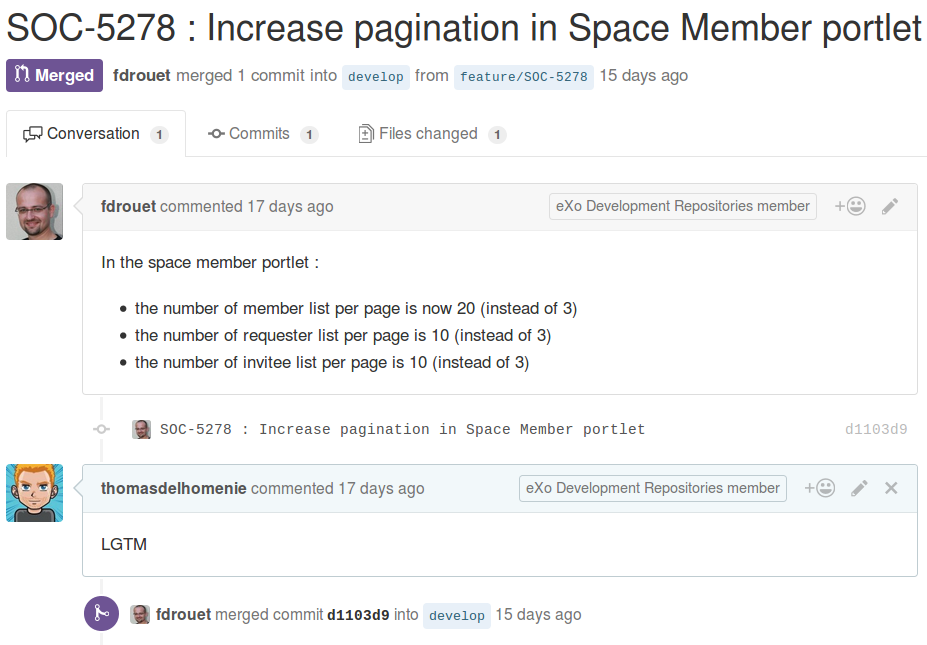
-
Clean your messOnce the PR has been merged, delete the branch in Github, and close the PR if it is not already marked as Merged or Closed.
|
Warning
|
Code Review does NOT mean Test, Reviewers are NOT TestersThe role of the reviewers is to review the code changes (code best practices, better/easier solution, …). They do not necessarily have to test (they can if they want/need of course). The author of the PR must not rely on the reviewers to test it, he/she is responsible for that (and the QA people will help during their test campaigns). |
Branching model
Branching model are 6 kinds of branch :
-
develop: Develop branch contains the latest delivered development changes. -
feature/xxx: Feature branches are dedicated branch for one big feature (lot of commits), "xxx" is the feature name. -
stable/xxx: Stable branch are used to perform releases and write / accept fix. "xxx" is the stable version name (e.g 1.0.x). -
fix/xxx: Fix branch is dedicated to integrate bugfix on Develop branch. If needed the fix is then cherry pick on stable branch. -
integration/xxx: Integration branches are dedicated branch to automatic integration task (like Crowdin translation). -
poc/xxx: Poc branches are dedicated branch to develop a Prove of Concept (PoC).
Feature Branch
Feature branches are dedicated branch to develop a new feature.
Actions
Create a new Feature Branch
When: A new feature is specified and planified.
Who: PL/TL
How:
-
If you want the branch deploy on Acceptance, do not create the branch by yourself but create a SWF ticket on Jira for the full package (Branches+CI+Acceptance).
-
If it’s a local feature project without need for CI or Acceptance you can create it by yourself.
Rebase Develop to Feature Branch
When: Frequently
Who: Team responsible of the branch with support of team responsible each project.
How:
git checkout develop
git pull
git checkout feature/x
git rebase develop
git push --forceMerge Feature Branch to Develop
When: Feature has been successfully tested by FQA. VPs give a GO.
Who: Team responsible of the branch with support of team responsible of each project
How:
git checkout feature/x
git rebase -i origin/develop
(remove initial commit)
git checkout develop
git pull
git merge --no-ff feature/x
git pushRemove a Feature Branch
When: Just after the merge of the feature branch to Develop
Who: PL/TL
How: Create SWF ticket on Jira to remove the full package (Branches+CI+Acceptance).
Fix Branch
Fix Branch are dedicated branch to fix a bug. The validation process may be different if the bug has been raised by FQA/TQA or by SM.
A fix branch is always created from Develop branch (except exceptional circumstance: fix on stable only).
Actions
Create a Fix Branch
When: A Jira issue has been created, time to resolve it is already estimated.
Who: Team responsible to fix the issue.
How:
git checkout develop
git pull
git checkout -b fix/issue
git pushMerge a Fix Branch to Develop
When:
-
If issue raised by TQA/FQA: After Engineering test
-
If issue raised by SM: After SM test
Who:
-
If issue raised by TQA/FQA: Team responsible to fix the issue
-
If issue raised by SM: SM
How:
git checkout fix/issue
git pull
git rebase origin/develop
git checkout develop
git pull
git merge fix/issue --squash
git commit -a
git pushRemove a Fix Branch
When: After the merge of the fix branch to Develop
Who: Team responsible to fix the issue.
How:
git push origin --delete fix/issue
git branch -d fix/issueStable Branch
Stable branch are used to perform releases and write / accept fix.
Actions
Create a new Stable Branch
When: When create the first Release Candidate version
Who: SWF
How: With a script similar to [createFB.sh](https://github.com/exoplatform/swf-scripts/blob/master/createFB.sh)
Create a Fix Branch to fix Stable Branch
In exceptional circumstance
When: A fix need to be done on a specific version but not on the on development version (fix a performance issue for instance)
Who: Team responsible to fix the issue after a Go from SM.
How:
git checkout stable/4.1.x
git pull
git checkout -b fix/4.1.x-issueMerge a Fix Branch to Stable
In exceptional circumstance
When: After SM test
Who: SM Team
How:
git checkout fix/4.1.x-issue
git checkout stable/4.1.x
git pull
git merge fix/4.1.x-issue --squash
git commit -a
git pushRemove a Fix Branch
When: After the merge of the fix branch to stable branch
Who: SM
How:
git push origin --delete fix/4.1.x-issue
git branch -d fix/4.1.x-issuePerform a release
When: After FQA/TQA test campaign. VPs give a GO.
Who: Release managers
How:
git clone [email protected]:exoplatform/xxx.git
cd xxx
# You checkout the release branch on which you need to perform a release.
git checkout stable/A.B.x
# You follow the classical maven release process
mvn release:prepare
mvn release:performMove a release tag
In really special case (when the test campaign show a critical issue after tagging but before nexus publishing) release manager still can apply a last minute commit and move the tag.
When: After FQA/TQA test campaign. VPs give a GO.
Who: Release managers
How:
# After your commit, just delete the remote tag, and create another one in this way
git tag -d 1.0.0
git push origin :refs/tags/1.0.0
git tag 1.0.0
git push origin 1.0.0Integration Branch
Integration branches are dedicated branch to automatic integration task (like Crowdin translation for instance).
Actions
Create a new Integration Branch
When: After a PLF release for Translation branches.
Who: SWF
How: Create from develop or stable/4.1.x. These branches have no maven version updated.
PoC Branch
Engineering
Poc branches are dedicated branch to develop a Prove of Concept (PoC).
Actions
Create a new PoC Branch
When: A new PoC is planified.
Who: PL/TL
How:
$ git checkout develop
$ git pull
$ git checkout -b poc/x
[Modify all pom: initial commit]
$ git add pom.xml
$ git commit -m "details"
$ git pushRelease Process
A release must never involve a freeze of the develop branch. This section explain the release process to follow when doing an intermediate release (Milestone, Release Candidate) or the final release.
Intermediate Release
When: Product Leader give a go to do an intermediate release of PLF (Milestone, Release Candidate)
Who: PLF Team with support of team responsible of each project
Final Release
When: Product Leader give a go to do the final release of PLF
Who: PLF Team with support of team responsible of each project
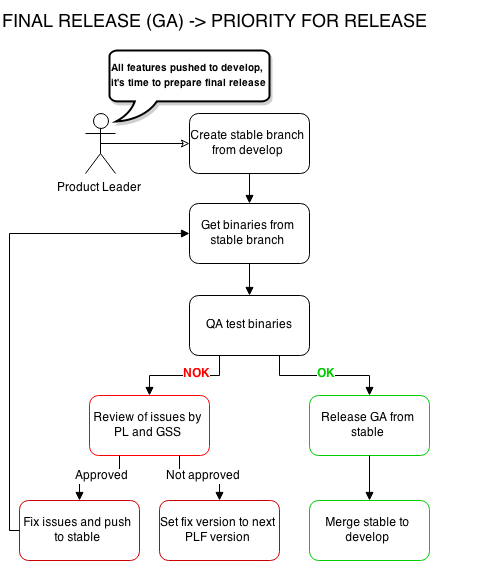
Community Contributions
Anyone with a Github account can contribute to eXo Platform. The only difference for people outside of the eXo Platform organization is they must sign a Contribution License Agreement. The Contributor License Agreement is needed to clarify the terms of usage of contributions by eXo Platform and the entire open source community.
The CLA must be printed, signed, then scanned as a PDF file and sent at [email protected].
Improvement
What is changing compare to 4.1
-
Clean history by using git rebase.
-
No more weekly merge between develop and master.
-
All fixes are push firstly to develop branch. Then SM backport what they need to stable.
-
Rebase develop to feature branch:
-
To do it regularly
-
To do it ONLY if develop branch is ok : build + acceptance are ok otherwise you’ll distribute shitty code everywhere
-
To do it for all projects in a given FB at the same time (to keep the coherency)
-
-
No more master branch on exodev repository. Master is only on blessed repository.
